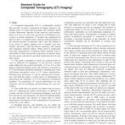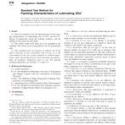No products
ASTM E1030-05
ASTM E1030-05 Standard Test Method for Radiographic Examination of Metallic Castings
standard by ASTM International, 12/01/2005
Full Description
1.1 This test method provides a uniform procedure for radiographic examination of metallic castings using radiographic film as the recording medium.
1.2 Due to the many complex geometries and part configurations inherent with cast products, it is necessary to recognize potential limitations associated with obtaining complete radiographic coverage on castings. Radiography of areas where geometry or part configuration does not allow achievement of complete coverage with practical radiographic methods shall be subject to mutual agreements between purchaser and supplier. The use of alternative nondestructive methods for areas that are not conducive to practical radiography shall also be specifically agreed upon between purchaser and supplier.
1.3 The radiographic method is highly sensitive to volumetric discontinuities that displace a detectable volume of cast material. Discontinuities that do not displace an appreciable volume of material, however, such as cracks or other planar-type indications, may not be detected with radiography unless the radiation beam is coincidentally aligned with the planar orientation of the discontinuity. In view of this limitation, it may be considered appropriate to use the radiographic method in conjunction with additional nondestructive methods that maintain reliable detection capabilities for these types of discontinuities. The use of additional methods shall be specifically agreed upon between the purchaser and supplier.
1.4 The radiographic techniques stated herein provide adequate assurance for defect detectability; however, it is recognized that, for special applications, specific techniques using more or less stringent requirements may be required than those specified. In these cases, the use of alternate radiographic techniques shall be as agreed upon between purchaser and supplier (also see Section ).
1.5 The values stated in inch-pound units are to be regarded as standard.
This standard does not purport to address all of the safety concerns, if any, associated with its use. It is the responsibility of the user of this standard to establish appropriate safety and health practices and determine the applicability of regulatory limitations prior to use.


































